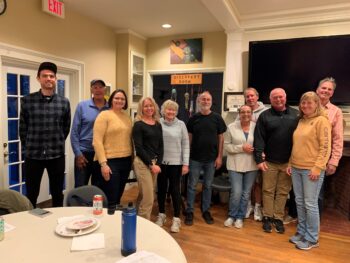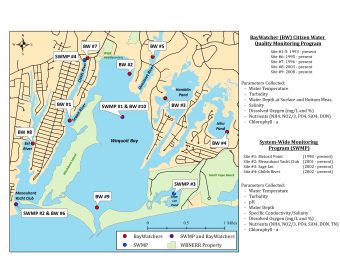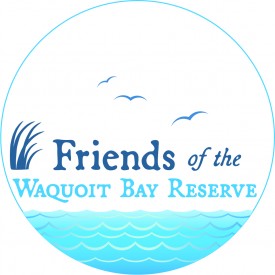Waquoit BayWatchers

2023 Waquoit BayWatchers Team
The Waquoit Bay Reserve’s Bay Watchers program was initiated in 1993, program is comprised of volunteer, citizen-based monitors who conduct field sampling and water quality measurements throughout the year. These monitors measure several key environmental parameters including temperature, salinity, dissolved oxygen, nutrients, and chlorophyll at ten sites in Waquoit Bay and its associated water bodies. Waquoit BayWatchers form a key data collection component of the Reserve’s Water Quality Database. Bay Watcher data expands geographic coverage of water quality sampling throughout the entire watershed, and provides comparative data at our four System Wide Monitoring Program (SWMP) stations. The Story of the Waquoit BayWatchers: Using Citizen Science for Water Quality Monitoring and Management (Presentation by Jordan Mora, Research Associate 2017) After Twenty Years, What Can the Waters in Waquoit Bay Tell Us? (Presentation by Jordan Mora, 2016)
Quality Assurance Project Plan (QAPP)
By developing a comprehensive Quality Assurance Project Plan (QAPP) for the Waquoit Bay Reserve, data from both water quality monitoring programs (System-wide Monitoring Program & Waquoit BayWatchers) can be incorporated into a regional database developed by the Cape Cod Commission and used to model nutrient dynamic changes.
The QAPP will strengthen the Reserve’s data collection process and enhance its ability to share and integrate data across private and academic institutions as well as state and federal agencies. This increased capacity for standardized data sharing is significant for this project but also for future collaborations.
The data are sent to the ape Cod Commission, for integration into the Cape Cod regional water quality database. The Cape Cod Commission makes this database publicly available for end-users including, but not limited to, the Cape Cod Water Protection Collaborative (“Collaborative”), a group with representatives from all fifteen Cape Cod towns and two Barnstable County representatives. The database is also available for end-users, such as scientists, restoration consultants, and regulatory agencies.





